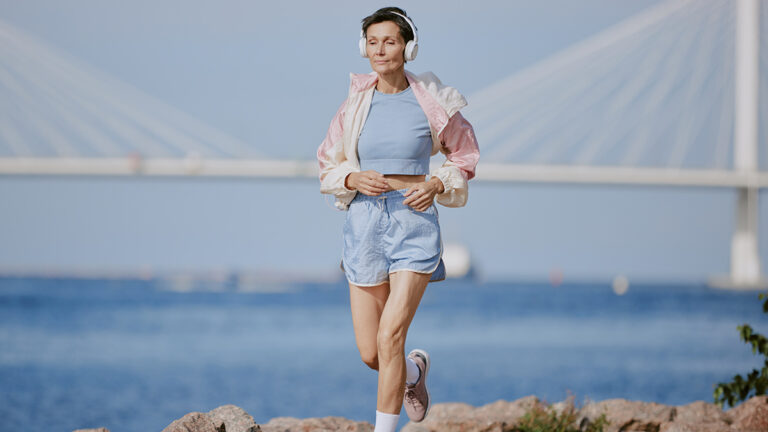Initially Published On TrainingPeaks Coach Blog linked here
Use these science-backed tips based on recent research to inform training decisions for athletes postmenopause.
The number of older athletes, especially women, participating in triathlons and endurance events continues to grow, which is wonderful for both the sport and the athletes themselves.
According to the RunSignup Annual Industry Report in 2023, 53% of participants were female, and 24% were in the 50+ age group. Team USA’s World Championship Finals roster includes 27% female athletes in the 50+ age group. This is impressive!
With so many older female athletes competing and staying active, coaches are responsible for guiding and supporting these women as they train, compete, and maintain their active lifestyles.
Unfortunately, most coaching certifications lack educational material focused on women-specific training postmenopause. As a coach, it’s up to you to follow the latest research and apply it to your athletes’ training.
The Physiological Changes of Menopause
Many people, including coaches and women themselves, don’t fully understand the major physiological changes that occur around age 52. This marks the average age for menopause, which is defined as the point when a woman has not had a menstrual cycle for 12 consecutive months.
While 52 is the average, some women transition earlier, even in their 40s, while others may experience it in their 60s. Additionally, surgeries such as a hysterectomy or the removal of ovaries can trigger menopause immediately.
Regardless of the cause, every biological woman eventually reaches menopause and spends the rest of her life in the postmenopausal stage. During this stage, levels of estrogen and progesterone decline. Although these are often referred to as sex hormones, they influence far more than just the reproductive system. These hormones impact physical, mental, and emotional health.
Fitness Fads Fail Postmenopausal Women
Postmenopausal women often discover that what worked in their younger years no longer yields the same results. Foods they could once eat without issue may now cause gut problems. Belly fat seems like it appears overnight.
Desperate for answers, many women experiment with new diets, supplements, or exercise routines—often without knowing whether these approaches are based on science. A quick Google search or social media scroll reveals a flood of misinformation.
Rarely do women consider adjusting their training routines for postmenopause. Even more rarely do they discuss these changes with their coaches.
Menopause, along with its impact on training, remains a taboo topic, leaving many women unsupported.
10 Tips for Adapting Training for Postmenopausal Women
Recently, a competitive athlete friend shared her struggles with declining performance. Once a race winner, she could no longer maintain the same paces she had a year earlier. At her age, her symptoms clearly pointed to perimenopause. She followed the same training program she had in her 30s, but it no longer produced results.
Coaches didn’t learn about menopause in school, and even now, finding valid resources requires effort.
To truly support female athletes, we must prioritize training postmenopause. Below are ten science-based strategies to help postmenopausal women stay healthy, active, and competitive while enjoying their active lifestyles.
1. Prioritize Strength Training
Postmenopausal women experience a natural decline in lean muscle mass and strength.
Sarcopenia—a condition marked by muscle loss—is more prevalent after menopause, making strength training essential. Shift the focus from weight loss to muscle building, as increased muscle mass improves metabolic health.
Include strength training year-round rather than only in the off-season. Focus on compound exercises like squats, lunges, deadlifts, rows, and push-ups. These movements engage multiple muscles and enhance functional strength. Avoid isolating small muscle groups unless absolutely necessary.
Proper form and technique are crucial. Start with lighter weights and progress gradually. Even women new to resistance training can see quick improvements, boosting both strength and confidence.
2. Improve Bone Density
Menopause accelerates bone loss, increasing the risk of fractures (especially if you’re a cyclist).
While aging makes this process unavoidable, weight-bearing exercises like strength training can slow it significantly. Plyometric training—such as jump rope, box jumps, and skipping—also helps maintain bone density.
Coaches can include these exercises as part of run sessions or cross-training. Consistency is key.
3. Optimize Nutrition
Many postmenopausal women unknowingly adopt low-calorie diets, which can harm their health. Training postmenopause requires matching energy intake to training demands. Hard training days call for more calories, while recovery days require less.
Protein intake becomes especially important. Aim for 25–35 grams of protein at each meal. Post-workout recovery meals should include both carbohydrates and protein to replenish glycogen stores and repair muscle. Avoid high-fat post-workout snacks, as they slow digestion.
Tip: A good resource for understanding nutrition needs for masters athlete’s can be found here: Addressing the Changing Nutrition Needs of Masters Athletes
4. Schedule More Recovery Time
Postmenopausal athletes often need 72 hours between hard sessions. A polarized training approach—keeping hard workouts intense and easy sessions light—works best.
Coaches should avoid scheduling long endurance sessions more than once or twice a week and focus on shorter, high-quality sessions during the week.
5. Focus on Mobility
Declining estrogen levels contribute to joint stiffness. Mobility exercises should become a regular part of training to improve flexibility and reduce injury risk.
Incorporate dynamic warm-ups, mobility drills, and, when needed, professional bike fittings to adjust for changes in flexibility.
6. Do Balance Exercises Daily
Hormonal changes increase the risk of falls in postmenopausal women. Balance exercises, such as single-leg stands or stability drills mentioned in this article, improve coordination and reduce this risk.
Encourage athletes to practice these exercises daily. It doesn’t need to take a lot of time–you can even accomplish some solid balance work while brushing your teeth!
7. Encourage Communication Around Menopause Symptoms
Symptoms like joint pain, poor sleep, and mood changes can persist for years.
Coaches should create a safe space for athletes to discuss these issues and adjust training plans as needed.
Open communication builds trust and empowers athletes.
8. Adopt a Team-Based Approach
Coaches don’t have to know everything. Collaborate with nutritionists, physical therapists, or pelvic floor specialists to provide well-rounded support. This team approach ensures athletes receive the care they need to thrive.
9. Cultivate a Positive Mindset With New Perspectives
Aging brings inevitable changes. Many athletes struggle when they can’t match their past performance.
Help them focus on new goals, celebrate small victories, and enjoy the process. Encourage them to explore new race formats, such as aquabike events, if running becomes difficult.
10. Have Fun!
This advice comes from Ruth Kazez, my first triathlon coach and a six-time IRONMAN finisher. Now in her 90s, Ruth continues to cycle, lift weights, and inspire countless athletes. She avoids the word “exercise,” saying it implies doing something only because “it’s good for you.”
Her advice? “Do what you love and have fun.” If workouts feel like a chore, it’s time for a change.

Conclusion
Training postmenopause requires a thoughtful and informed approach. Coaches must stay current on research and adapt training programs to address the unique needs of postmenopausal women. By focusing on strength, recovery, and mindset, we can help these athletes stay healthy, competitive, and joyful for years to come.
By using these strategies, coaches can empower women to embrace this life stage and continue doing what they love—just like Ruth, who at 80 competed in the Happy Valley Sprint Triathlon. Let’s help more women stay active and inspired!
References
Arntz, F., et al. (2022, June 27). Effect of Plyometric Jump Training on Skeletal Muscle Hypertrophy in Healthy Individuals: A Systematic Review With Multilevel Meta-Analysis. Retrieved from https://pubmed.ncbi.nlm.nih.gov/35832484/
Buckinx, F., & Aubertin-Leheudre, M. (2022, June 23). Sarcopenia in Menopausal Women: Current Perspectives. Retrieved from https://pmc.ncbi.nlm.nih.gov/articles/PMC9235827/
Burrup, R., et al. (2018, January). Strength training and body composition in middle-age women. Retrieved from https://pubmed.ncbi.nlm.nih.gov/28181774/
Carneiro, M., et al. (2023, March 29). Effect of Different Load Intensity Transition Schemes on Muscular Strength and Physical Performance in Postmenopausal Women. Retrieved from https://pubmed.ncbi.nlm.nih.gov/36989529/
Chidi-Ogbolu, N., & Baar, K. (2019, January 19). Effect of Estrogen on Musculoskeletal Performance and Injury Risk. Retrieved from https://www.frontiersin.org/journals/physiology/articles/10.3389/fphys.2018.01834/full
Clayton, A., & Nina P. (2010). Depression or menopause? Presentation and management of major depressive disorder in perimenopausal and postmenopausal women. Retrieved from https://pubmed.ncbi.nlm.nih.gov/20582297/
Finkelstein, J., et al. (2008, March). Bone mineral density changes during the menopause transition in a multiethnic cohort of women. Retrieved from https://pubmed.ncbi.nlm.nih.gov/18160467/
Muhammad Lokman Md, I., et al. (2022, April 27). Fracture Risk Factor in Post-Menopausal Women with Deterioration of Bone Density. Retrieved from https://pubmed.ncbi.nlm.nih.gov/35706861/
García-Pinillos F., et al. (2020, March 12). Jump-Rope Training: Improved 3-km Time-Trial Performance in Endurance Runners via Enhanced Lower-Limb Reactivity and Foot-Arch Stiffness. Retrieved from https://pubmed.ncbi.nlm.nih.gov/32163923/
Moore, D. (2014, September 1). Keeping Older Muscle “Young” through Dietary Protein and Physical Activity. Retrieved from https://pmc.ncbi.nlm.nih.gov/articles/PMC4188243/

